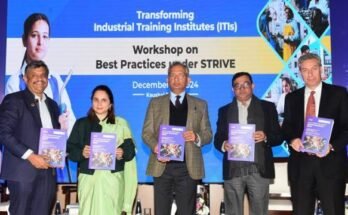New Delhi : It is estimated that the working-age population, between 15 and 64 years, will rise by 125 million over the coming decade and a further 103 million over the following one. However, a recent survey showed no net new jobs were created between 2004-05 and 2009-10, a dramatic slowdown in the previous five years, when 60 million jobs were created. Below are the excerpts from the interview of Mr. Rohit Nandan by a reporter:
Where are these skilled people we hear so much about? It seems there are more talks and less action.
Skilling is a very intangible concept. How will you, especially in an urban environment, actually perceive the difference it is making? More, it is a very hierarchical concept. As we see it, 12-13 million Indians need to be skilled every year. But, not everyone has to have skills in the same order or level.
To start with, you need skills of a very local variety. The skilled person need not have skills of national standards; just traditional or local skills will do. Good enough for the market he is catering to. If a skilled worker wants to move from one state to another to work, his skills are usable or transferable. So his skills and certification have to be nationally recognisable. His certification should hold good in the other state.
Third, we need skills that can be exported. If a person wants to migrate out of India, the skills he requires have to be a different order altogether. Here, quality is very relevant. To export our workers – construction workers, plumbers, electricians, carpenters, nursing staff, beauty care experts – to the UK or even the Middle East needs a different type and level of skilling.
We are primarily focusing on the first two. For the first time, last year, we were able to skill around 10.4 million people. This does not take into account of skilling that is being done by industry or employers directly. This is only through our system, where loans have been taken through National Skill Development Corporation (NSDC). This includes ITIs (Industrial Training Institutes), government-backed training and private training done with loans from government sources. This doesn’t include TCS, Wipro, Welspun and others who train directly. If we include this, the numbers would go to 12.5-13 million in the year.
How are you creating training capacity?
When this ministry was formed, there were around 1,700 centres through which training was being imparted. This has gone up to around 8,000. We have financed new centres through loans to the tune of around Rs 2,200 crore. The centres are run by the private partners to whom we offer a loan at a concessional rate.
The biggest complaint we have faced in the past is that we are not delivering the kind of skilled people businesses require. They need oranges and we are delivering apples. So, in 2009, it was decided that the entire task of creating course or training content would be handed over to industry. So, NSDC is now led almost entirely by the private sector. The whole idea is that the skilling eco-system should be led by business.
We created 40-odd sector skill councils, each headed by a major player in that sector. All courses are decided by them. We have developed 4,000 national occupational standards (NOS). Now, I am in the happy position of asking business why it is not skilling people to its own requirements. We have also established an electronic platform to bring the two together. There could be a trained worker in Bengal and someone might need him in Tamil Nadu.
How do they find each other?
Around 60,000 listings have come on our electronic platform since 2014. If an industry in Maharashtra requires 10 welders, it can go on the site and find them. Although this is a passive way of bringing them together, we will be partnering with sites like naukri.com to allow them to access and use our database on a non-exclusive basis.
We have also done a study to see where our skilled workers can be exported. We think there could be a market for Indian geriatric caregivers to the West. The biggest quality of Indians is our ability to give care. For instance, the ageing population in Japan could well use the services of young girls from the northeast. There is a physical and cultural similarity, and with some language skills, this could be a good fit. We are closely studying where such similarities can work to the advantage of both countries.
If it is working so well, shouldn’t there be a spurt in the employment figures? Shouldn’t all this help solve what seems to be a gargantuan problem?
This is perhaps the only thing we cannot do. New jobs are a function of how well your economy is faring and growing. We can make people job-ready but we can’t create jobs. We don’t have a magic wand. It’s unfair to expect the skill ministry to fill this void. If there are more hotels, they will require more chefs, more waiters, more front desk managers. I can supply those but I can’t build more hotels.
Note: Interview for public awareness with reference from the information provided at online news portals.



